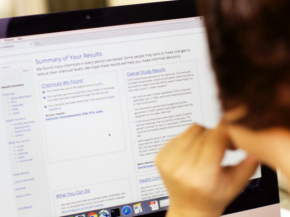Digital Exposure Report-Back Interface (DERBI)

Thanks to advances in technology, scientists in environmental health studies are now able to detect a wide variety of contaminants in people’s bodies and in their homes. Increasingly, participants in these studies want to know what their chemical levels are, even when the health effects are uncertain. To ensure that information from these kinds of studies is shared effectively and ethically, scientists need new tools for communicating results to participants.
Tools like these are critical as we enter the era of precision medicine—a new approach to disease prevention and treatment that takes into account not just genes and lifestyle, but also environmental exposures as well. In fact, one of the key requirements of the President’s Precision Medicine Initiative (PMI), which seeks to engage a million volunteers to contribute their health data for research, is to ensure that the sharing of personal results with study participants is done responsibly. To support the return of high-quality, personal results from environmental exposure studies, researchers at Silent Spring developed the Digital Exposure Report-Back Interface, or DERBI. This interactive web-based tool takes complex chemical exposure data and presents it in a way that the average person can understand.
Each report is personalized and includes a summary of results—what chemicals were found, what health concerns they raise, and what actions people can take to protect their health—as well as an explanation of the study’s overall findings. By clicking on different parts of the report, users can delve deeper into their results. They can zoom in on a particular class of chemicals and get tips on how to reduce their exposures, such as avoiding products with fragrances or keeping dust levels low in the home. Or users can see how their results compare with those of other participants, whether their chemical levels are higher or lower than the average. Results are presented graphically to make the information easy to interpret; hovering with a mouse over different parts of a graph triggers little pop-up messages that help participants interpret what they are seeing.
Not only is DERBI a model for reporting personal exposure results, researchers also can use the technology to gain new insights in environmental health. DERBI was developed in collaboration with researchers at the Harvard School of Engineering and Applied Sciences, as well as the Harvard School of Public Health, the University of California, Berkeley, and Northeastern University.
View sample reports:
- PROTECT Superfund Research Program (web: Spanish and English)
- Women Firefighters Biomonitoring Collaborative (web)
- CDC’s Green Housing Study (print)
- Child Health and Development Studies (web)
- STEEP Private Wells Study (web)
- Illinois Kids Development Study (IKIDS) (web). Enter access code 'IKIDS' to view a sample report. This report is meant to be viewed on a smartphone.
Funded by
News & Updates
2019
Silent Spring has been a major driver in advancing the field of report-back—a practice that ensures participants have access to their study results and what they mean for their health.